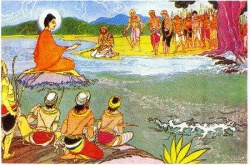Difference between revisions of "108 (number)"
| Line 1: | Line 1: | ||
[[File:Mind Teasers.jpg|thumb|250px|]] | [[File:Mind Teasers.jpg|thumb|250px|]] | ||
<poem> | <poem> | ||
| − | 108 (one hundred [and] eight) is the natural number following 107 and preceding 109. | + | [[108]] (one hundred [and] eight) is the natural number following 107 and preceding 109. |
| − | Religion and the arts | + | [[Religion]] and the arts |
| − | The number 108 is considered sacred by several Eastern religions, such as Hinduism, Buddhism, Jainism, connected yoga and dharma based practices. In Sikhism all numbers, weekdays, months etc. are equally auspicious or inauspicious. The individual digits comprising 108; 1, 0, and 8 represent one thing, nothing, and everything (infinity), representing the belief of the ultimate reality of the universe as being (paradoxically) simultaneously one, emptiness, and infinite.[dubious – discuss] | + | The number [[108]] is considered [[sacred]] by several Eastern [[religions]], such as [[Hinduism]], [[Buddhism]], [[Jainism]], connected [[yoga]] and [[dharma]] based practices. In {{Wiki|Sikhism}} all numbers, weekdays, months etc. are equally [[auspicious]] or {{Wiki|inauspicious}}. The {{Wiki|individual}} digits comprising [[108]]; 1, 0, and 8 represent one thing, [[nothing]], and everything ([[infinity]]), representing the [[belief]] of the [[ultimate reality]] of the [[universe]] as being ({{Wiki|paradoxically}}) simultaneously one, [[emptiness]], and [[infinite]].[dubious – discuss] |
| − | Hinduism | + | [[Hinduism]] |
| − | Hindu deities have 108 names, while in Gaudiya Vaishnavism, there are 108 gopis of Vrindavan. Recital of these names, often accompanied by the counting of a 108-beaded mala, is considered sacred and often done during religious ceremonies. The recital is called namajapa. Accordingly, a japa mala usually has beads for 108 repetitions of a mantra. | + | [[Hindu]] [[deities]] have [[108]] names, while in {{Wiki|Gaudiya}} [[Vaishnavism]], there are [[108]] gopis of {{Wiki|Vrindavan}}. Recital of these names, often accompanied by the counting of a 108-beaded [[mala]], is considered [[sacred]] and often done during [[religious]] {{Wiki|ceremonies}}. The recital is called namajapa. Accordingly, a [[japa]] [[mala]] usually has beads for [[108]] repetitions of a [[mantra]]. |
| − | Srivaishnavism has 108 Divya Kshetras of Lord Vishnu, called as 108 DivyaDesam. | + | Srivaishnavism has [[108]] Divya [[Kshetras]] of [[Lord]] [[Vishnu]], called as [[108]] DivyaDesam. |
| − | Buddhism | + | [[Buddhism]] |
[[File:5sdf.jpg|thumb|250px|]] | [[File:5sdf.jpg|thumb|250px|]] | ||
| − | Likewise, Tibetan Buddhist malas or rosaries (Tib. ཕྲེང་བ Wyl. phreng ba, "Trengwa") are usually 108 beads; sometimes 111 including the guru bead(s), reflecting the words of the Buddha called in Tibetan the Kangyur (Wylie: Bka'-'gyur) in 108 volumes. Zen priests wear juzu (a ring of prayer beads) around their wrists, which consists of 108 beads. | + | Likewise, [[Tibetan Buddhist]] malas or {{Wiki|rosaries}} (Tib. {{BigTibetan|ཕྲེང་བ}} Wyl. phreng ba, "Trengwa") are usually [[108]] beads; sometimes 111 including the [[guru]] bead(s), reflecting the words of the [[Buddha]] called in [[Tibetan]] the [[Kangyur]] (Wylie: Bka'-'gyur) in [[108]] volumes. [[Zen]] {{Wiki|priests}} wear juzu (a ring of [[prayer beads]]) around their wrists, which consists of [[108]] beads. |
| − | The Lankavatara Sutra has a section where the Bodhisattva Mahamati asks Buddha 108 questions and another section where Buddha lists 108 statements of negation in the form of "A statement concerning X is not statement concerning X". In a footnote, D.T. Suzuki explains that the Sanskrit word translated as "statement" is pada which can also mean "foot-step" or "a position." This confusion over the word "pada" explains why some have mistakenly held that the reference to 108 statements in the Lankavatara refer to the 108 steps that many temples have. | + | The [[Lankavatara]] [[Sutra]] has a section where the [[Bodhisattva]] [[Mahamati]] asks [[Buddha]] [[108]] questions and another section where [[Buddha]] lists [[108]] statements of {{Wiki|negation}} in the [[form]] of "A statement concerning X is not statement concerning X". In a footnote, {{Wiki|D.T. Suzuki}} explains that the [[Sanskrit]] [[word]] translated as "statement" is pada which can also mean "foot-step" or "a position." This {{Wiki|confusion}} over the [[word]] "pada" explains why some have mistakenly held that the reference to [[108]] statements in the [[Lankavatara]] refer to the [[108]] steps that many [[temples]] have. |
| − | In some schools of Buddhism it is believed that there are 108 feelings. According to Bhante Gunaratana this number is reached by multiplying the senses smell, touch, taste, hearing, sight, and consciousness by whether they are painful, pleasant or neutral, and then again by whether these are internally generated or externally occurring, and yet again by past, present and future, finally we get 108 feelings. 6 × 3 × 2 × 3 = 108. In Japan, at the end of the year, a bell is chimed 108 times in Buddhist temples to finish the old year and welcome the new one. Each ring represents one of 108 earthly temptations a person must overcome to achieve nirvana. | + | In some [[schools of Buddhism]] it is believed that there are [[108]] [[feelings]]. According to [[Bhante Gunaratana]] this number is reached by multiplying the [[senses]] {{Wiki|smell}}, {{Wiki|touch}}, {{Wiki|taste}}, hearing, [[sight]], and [[consciousness]] by whether they are [[painful]], [[pleasant]] or [[neutral]], and then again by whether these are internally generated or externally occurring, and yet again by past, present and future, finally we get [[108]] [[feelings]]. 6 × 3 × 2 × 3 = [[108]]. In [[Japan]], at the end of the year, a [[bell]] is chimed [[108]] times in [[Buddhist]] [[temples]] to finish the old year and welcome the new one. Each ring represents one of [[108]] [[earthly]] temptations a [[person]] must overcome to achieve [[nirvana]]. |
| − | Ancient artifacts | + | {{Wiki|Ancient}} artifacts |
[[File:Mind-suc.jpg|thumb|250px|]] | [[File:Mind-suc.jpg|thumb|250px|]] | ||
| − | The pre-historic monument Stonehenge is about 108 feet in diameter. | + | The pre-historic monument Stonehenge is about [[108]] feet in diameter. |
Other references | Other references | ||
| − | In the neo-Gnostic teachings of Samael Aun Weor, an individual has 108 chances (lifetimes) to eliminate his egos and transcend the material world before "devolving" and having the egos forcefully removed in the infradimensions. | + | In the neo-Gnostic teachings of Samael Aun Weor, an {{Wiki|individual}} has [[108]] chances (lifetimes) to eliminate his egos and transcend the material [[world]] before "devolving" and having the egos forcefully removed in the infradimensions. |
| − | Martial arts | + | {{Wiki|Martial arts}} |
| − | Many East Asian martial arts trace their roots back to Buddhism, specifically, to the Buddhist Shaolin Temple. Because of their ties to Buddhism, 108 has become an important symbolic number in a number of martial arts styles. | + | Many {{Wiki|East Asian}} {{Wiki|martial arts}} trace their [[roots]] back to [[Buddhism]], specifically, to the [[Buddhist]] [[Shaolin Temple]]. Because of their ties to [[Buddhism]], [[108]] has become an important [[symbolic]] number in a number of {{Wiki|martial arts}} styles. |
| − | According to Marma Adi and Ayurveda, there are 108 pressure points in the body, where consciousness and flesh intersect to give life to the living being. | + | According to Marma Adi and [[Ayurveda]], there are [[108]] pressure points in the [[body]], where [[consciousness]] and flesh intersect to give [[life]] to the [[living being]]. |
| − | The Chinese school of martial arts agrees with the South Indian school of martial arts on the principle of 108 pressure points. | + | The {{Wiki|Chinese}} school of {{Wiki|martial arts}} agrees with the [[South]] [[Indian]] school of {{Wiki|martial arts}} on the [[principle]] of [[108]] pressure points. |
| − | 108 number figures prominently in the symbolism associated with karate, particularly the Gōjū-ryū discipline. The ultimate Gōjū-ryū kata, Suparinpei, literally translates to 108. Suparinpei is the Chinese pronunciation of the number 108, while gojūshi of Gojūshiho is the Japanese pronunciation of the number 54. The other Gōjū-ryū kata, Sanseru (meaning "36") and Seipai ("18") are factors of the number 108. | + | [[108]] number figures prominently in the [[symbolism]] associated with karate, particularly the Gōjū-ryū [[discipline]]. The [[Wikipedia:Absolute (philosophy)|ultimate]] Gōjū-ryū [[kata]], Suparinpei, literally translates to [[108]]. Suparinpei is the {{Wiki|Chinese}} pronunciation of the number [[108]], while gojūshi of Gojūshiho is the [[Japanese]] pronunciation of the number 54. The other Gōjū-ryū [[kata]], Sanseru (meaning "36") and Seipai ("18") are factors of the number [[108]]. |
| − | The 108 moves of the Yang Taijiquan long form and 108 moves in the Wing Chun wooden dummy form, taught by Yip Man, are noted in this regard. | + | The [[108]] moves of the Yang {{Wiki|Taijiquan}} long [[form]] and [[108]] moves in the Wing Chun wooden dummy [[form]], taught by Yip Man, are noted in this regard. |
| − | Paek Pal Ki Hyung, the 7th form taught in the art of Kuk Sool Won, translates literally to "108 technique" form. It is also frequently referred to as the "eliminate 108 torments" form. Each motion corresponds with one of the 108 Buddhist torments or defilements. | + | Paek Pal Ki Hyung, the 7th [[form]] taught in the [[art]] of Kuk Sool Won, translates literally to "[[108]] technique" [[form]]. It is also frequently referred to as the "eliminate [[108]] torments" [[form]]. Each motion corresponds with one of the [[108]] [[Buddhist]] torments or [[defilements]]. |
[[File:Amida do mount Hiei.JPG|thumb|250px|]] | [[File:Amida do mount Hiei.JPG|thumb|250px|]] | ||
| − | In literature | + | In {{Wiki|literature}} |
In Homer's Odyssey, the number of suitors coveting Penelope, wife of Odysseus. | In Homer's Odyssey, the number of suitors coveting Penelope, wife of Odysseus. | ||
| − | There are 108 outlaws in the Chinese classic Water Margin/Outlaws of the Marsh by Shi Nai'an and Luo Guanzhong. | + | There are [[108]] outlaws in the {{Wiki|Chinese}} classic [[Water]] Margin/Outlaws of the Marsh by Shi Nai'an and Luo Guanzhong. |
| − | There are 108 love sonnets in Astrophil and Stella, the first English sonnet sequence by Sir Philip Sidney. | + | There are [[108]] [[love]] sonnets in Astrophil and Stella, the first English sonnet sequence by Sir Philip Sidney. |
In sports | In sports | ||
| − | 108 is the number that the Belgian cyclist Wouter Weylandt wore when he crashed fatally in the Giro d'Italia on May 9, 2011. As a tribute, many supporters held replicas of his race number by the side of the road the next day. The organization of the Giro d'Italia decided not to issue race number 108 in future editions, to commemorate him. | + | [[108]] is the number that the Belgian cyclist Wouter Weylandt wore when he crashed fatally in the Giro d'Italia on May 9, 2011. As a tribute, many supporters held replicas of his race number by the side of the road the next day. The organization of the Giro d'Italia decided not to issue race number [[108]] in future editions, to commemorate him. |
In other fields | In other fields | ||
[[File:Lb23.jpg|thumb|250px|]] | [[File:Lb23.jpg|thumb|250px|]] | ||
| − | Sesame Street muppet Count von Count's favourite number, 34969, is 187x187 (1872), speculated in a BBC mathematics programme to be a reference between Count Dracula and the Californian murder code [1] | + | {{Wiki|Sesame}} Street muppet Count von Count's favourite number, 34969, is 187x187 (1872), speculated in a {{Wiki|BBC}} {{Wiki|mathematics}} programme to be a reference between Count Dracula and the Californian murder code [1] |
| − | The Manga series Death Note has 108 chapters. | + | The Manga series [[Death]] Note has [[108]] chapters. |
| − | An official Major League Baseball baseball has 108 stitches. | + | An official Major League Baseball baseball has [[108]] stitches. |
| − | In the Manga and Anime series Shikabane Hime Aka and Shikabane Hime Kuro (Corpse Princess), the shikabane himes must hunt 108 evil undead corpses in order to ascend to heaven. | + | In the Manga and Anime series Shikabane Hime Aka and Shikabane Hime Kuro (Corpse {{Wiki|Princess}}), the shikabane himes must hunt [[108]] [[evil]] undead corpses in order to ascend to [[heaven]]. |
| − | In the Manga & Anime series One Piece the supernova "Mad Monk" Urouge has a bounty 108,000,000 berri. | + | In the Manga & Anime series One Piece the supernova "Mad [[Monk]]" Urouge has a bounty 108,000,000 berri. |
| − | In Sekirei there are 108 Sekirei released into the world. | + | In Sekirei there are [[108]] Sekirei released into the [[world]]. |
| − | The atomic number of hassium. | + | The [[atomic]] number of hassium. |
| − | The number of Mbit/s of a non-standard extension of IEEE 802.11g wireless network using channel bonding. | + | The number of Mbit/s of a non-standard extension of IEEE 802.11g wireless network using [[channel]] bonding. |
| − | There are 108 Stars of Destiny to collect in the Suikoden video game series distributed by Konami for PlayStation. The Stars of Destiny are based on outlaws from the classical Chinese novel, Water Margin, by Shi Nai'an and Luo Guanzhong. | + | There are [[108]] Stars of [[Destiny]] to collect in the Suikoden video game series distributed by Konami for PlayStation. The Stars of [[Destiny]] are based on outlaws from the classical {{Wiki|Chinese}} {{Wiki|novel}}, [[Water]] Margin, by Shi Nai'an and Luo Guanzhong. |
| − | In the video game Legend of Dragoon for PlayStation, there are 108 species; the 108th of which is the God of destruction. Its soul returns to the world every 108 years to find a host. | + | In the video game Legend of Dragoon for PlayStation, there are [[108]] species; the 108th of which is the [[God]] of destruction. Its [[soul]] returns to the [[world]] every [[108]] years to find a host. |
| − | 108 is the name of a community of and for open source developers, created by Red Hat. | + | [[108]] is the [[name]] of a {{Wiki|community}} of and for open source developers, created by Red Hat. |
| − | There are 108 cards in a deck of UNO cards. | + | There are [[108]] cards in a deck of UNO cards. |
| − | There are 108 Code Crowns in Digimon Fusion. | + | There are [[108]] Code Crowns in Digimon Fusion. |
| − | Volume expansion of freezing water is roughly 108%. | + | Volume expansion of freezing [[water]] is roughly [[108]]%. |
A vault in Fallout 3 full of Gary clones. | A vault in Fallout 3 full of Gary clones. | ||
| − | In Batman: Arkham City, there are a total of 108 medals for each Batman and Catwoman to collect in the 12 campaigns of the Riddler's Revenge. There are also several other references to LOST throughout the game. | + | In Batman: Arkham City, there are a total of [[108]] medals for each Batman and Catwoman to collect in the 12 campaigns of the Riddler's Revenge. There are also several other references to LOST throughout the game. |
| − | 108 degrees Fahrenheit is the internal temperature at which the human body's vital organs begin to fail from overheating. | + | [[108]] degrees Fahrenheit is the internal temperature at which the [[human]] [[body's]] [[vital]] organs begin to fail from overheating. |
| − | In the TV show Lost, the main characters must enter the numbers 4 8 15 16 23 42 into a mysterious computer every 108 minutes. | + | In the TV show Lost, the main characters must enter the numbers 4 8 15 16 23 42 into a mysterious computer every [[108]] minutes. |
| − | In India, 108 (1-0-8) is the toll-free emergency telephone number. | + | In [[India]], [[108]] (1-0-8) is the toll-free emergency telephone number. |
</poem> | </poem> | ||
{{R}} | {{R}} | ||
{{W}} | {{W}} | ||
[[Category:108]] | [[Category:108]] | ||
Revision as of 08:04, 21 November 2013
108 (one hundred [and] eight) is the natural number following 107 and preceding 109.
Religion and the arts
The number 108 is considered sacred by several Eastern religions, such as Hinduism, Buddhism, Jainism, connected yoga and dharma based practices. In Sikhism all numbers, weekdays, months etc. are equally auspicious or inauspicious. The individual digits comprising 108; 1, 0, and 8 represent one thing, nothing, and everything (infinity), representing the belief of the ultimate reality of the universe as being (paradoxically) simultaneously one, emptiness, and infinite.[dubious – discuss]
Hinduism
Hindu deities have 108 names, while in Gaudiya Vaishnavism, there are 108 gopis of Vrindavan. Recital of these names, often accompanied by the counting of a 108-beaded mala, is considered sacred and often done during religious ceremonies. The recital is called namajapa. Accordingly, a japa mala usually has beads for 108 repetitions of a mantra.
Srivaishnavism has 108 Divya Kshetras of Lord Vishnu, called as 108 DivyaDesam.
Buddhism
Likewise, Tibetan Buddhist malas or rosaries (Tib. ཕྲེང་བ Wyl. phreng ba, "Trengwa") are usually 108 beads; sometimes 111 including the guru bead(s), reflecting the words of the Buddha called in Tibetan the Kangyur (Wylie: Bka'-'gyur) in 108 volumes. Zen priests wear juzu (a ring of prayer beads) around their wrists, which consists of 108 beads.
The Lankavatara Sutra has a section where the Bodhisattva Mahamati asks Buddha 108 questions and another section where Buddha lists 108 statements of negation in the form of "A statement concerning X is not statement concerning X". In a footnote, D.T. Suzuki explains that the Sanskrit word translated as "statement" is pada which can also mean "foot-step" or "a position." This confusion over the word "pada" explains why some have mistakenly held that the reference to 108 statements in the Lankavatara refer to the 108 steps that many temples have.
In some schools of Buddhism it is believed that there are 108 feelings. According to Bhante Gunaratana this number is reached by multiplying the senses smell, touch, taste, hearing, sight, and consciousness by whether they are painful, pleasant or neutral, and then again by whether these are internally generated or externally occurring, and yet again by past, present and future, finally we get 108 feelings. 6 × 3 × 2 × 3 = 108. In Japan, at the end of the year, a bell is chimed 108 times in Buddhist temples to finish the old year and welcome the new one. Each ring represents one of 108 earthly temptations a person must overcome to achieve nirvana.
Ancient artifacts
The pre-historic monument Stonehenge is about 108 feet in diameter.
Other references
In the neo-Gnostic teachings of Samael Aun Weor, an individual has 108 chances (lifetimes) to eliminate his egos and transcend the material world before "devolving" and having the egos forcefully removed in the infradimensions.
Martial arts
Many East Asian martial arts trace their roots back to Buddhism, specifically, to the Buddhist Shaolin Temple. Because of their ties to Buddhism, 108 has become an important symbolic number in a number of martial arts styles.
According to Marma Adi and Ayurveda, there are 108 pressure points in the body, where consciousness and flesh intersect to give life to the living being.
The Chinese school of martial arts agrees with the South Indian school of martial arts on the principle of 108 pressure points.
108 number figures prominently in the symbolism associated with karate, particularly the Gōjū-ryū discipline. The ultimate Gōjū-ryū kata, Suparinpei, literally translates to 108. Suparinpei is the Chinese pronunciation of the number 108, while gojūshi of Gojūshiho is the Japanese pronunciation of the number 54. The other Gōjū-ryū kata, Sanseru (meaning "36") and Seipai ("18") are factors of the number 108.
The 108 moves of the Yang Taijiquan long form and 108 moves in the Wing Chun wooden dummy form, taught by Yip Man, are noted in this regard.
Paek Pal Ki Hyung, the 7th form taught in the art of Kuk Sool Won, translates literally to "108 technique" form. It is also frequently referred to as the "eliminate 108 torments" form. Each motion corresponds with one of the 108 Buddhist torments or defilements.
In literature
In Homer's Odyssey, the number of suitors coveting Penelope, wife of Odysseus.
There are 108 outlaws in the Chinese classic Water Margin/Outlaws of the Marsh by Shi Nai'an and Luo Guanzhong.
There are 108 love sonnets in Astrophil and Stella, the first English sonnet sequence by Sir Philip Sidney.
In sports
108 is the number that the Belgian cyclist Wouter Weylandt wore when he crashed fatally in the Giro d'Italia on May 9, 2011. As a tribute, many supporters held replicas of his race number by the side of the road the next day. The organization of the Giro d'Italia decided not to issue race number 108 in future editions, to commemorate him.
In other fields
Sesame Street muppet Count von Count's favourite number, 34969, is 187x187 (1872), speculated in a BBC mathematics programme to be a reference between Count Dracula and the Californian murder code [1]
The Manga series Death Note has 108 chapters.
An official Major League Baseball baseball has 108 stitches.
In the Manga and Anime series Shikabane Hime Aka and Shikabane Hime Kuro (Corpse Princess), the shikabane himes must hunt 108 evil undead corpses in order to ascend to heaven.
In the Manga & Anime series One Piece the supernova "Mad Monk" Urouge has a bounty 108,000,000 berri.
In Sekirei there are 108 Sekirei released into the world.
The atomic number of hassium.
The number of Mbit/s of a non-standard extension of IEEE 802.11g wireless network using channel bonding.
There are 108 Stars of Destiny to collect in the Suikoden video game series distributed by Konami for PlayStation. The Stars of Destiny are based on outlaws from the classical Chinese novel, Water Margin, by Shi Nai'an and Luo Guanzhong.
In the video game Legend of Dragoon for PlayStation, there are 108 species; the 108th of which is the God of destruction. Its soul returns to the world every 108 years to find a host.
108 is the name of a community of and for open source developers, created by Red Hat.
There are 108 cards in a deck of UNO cards.
There are 108 Code Crowns in Digimon Fusion.
Volume expansion of freezing water is roughly 108%.
A vault in Fallout 3 full of Gary clones.
In Batman: Arkham City, there are a total of 108 medals for each Batman and Catwoman to collect in the 12 campaigns of the Riddler's Revenge. There are also several other references to LOST throughout the game.
108 degrees Fahrenheit is the internal temperature at which the human body's vital organs begin to fail from overheating.
In the TV show Lost, the main characters must enter the numbers 4 8 15 16 23 42 into a mysterious computer every 108 minutes.
In India, 108 (1-0-8) is the toll-free emergency telephone number.




